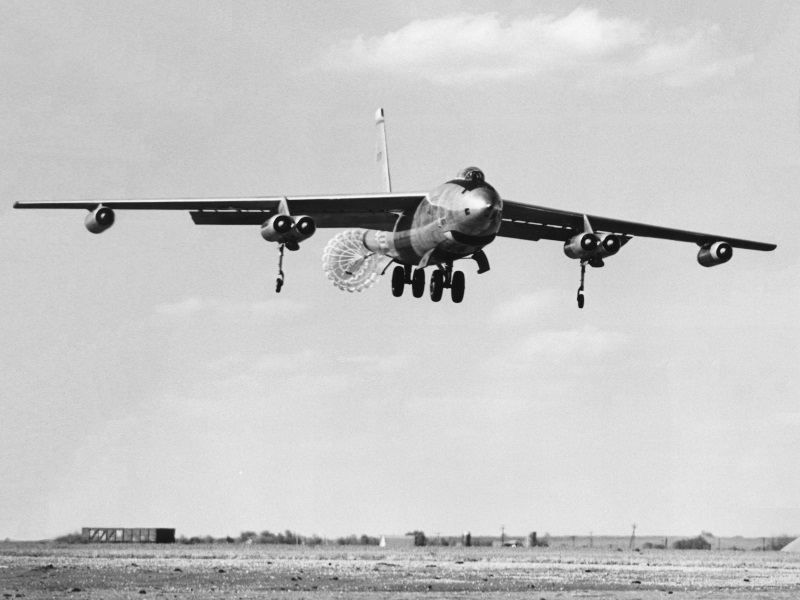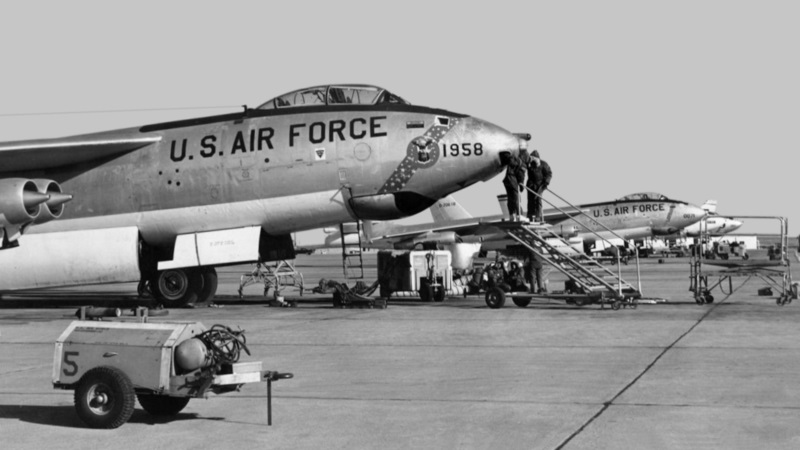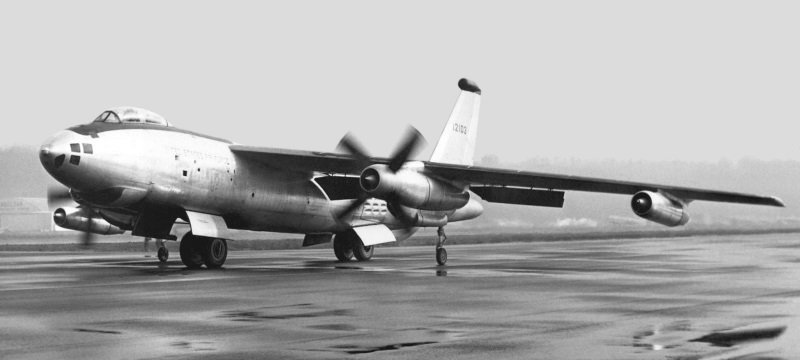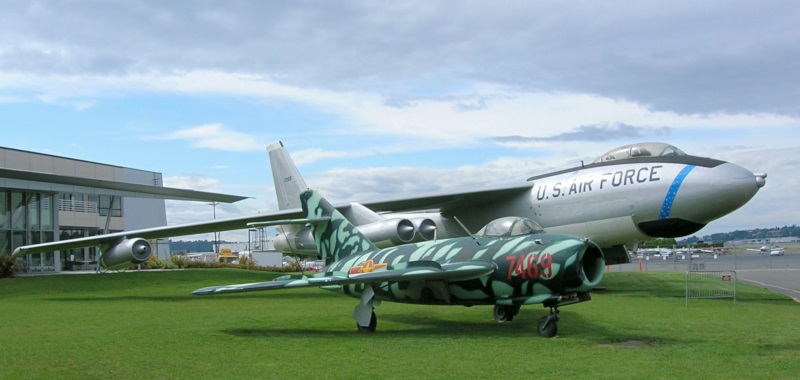
* The Boeing B-47 was the first line of America's strategic defense in the late 1950s and early 1960s, the backbone of the US nuclear deterrent against the USSR. While it was primarily a nuclear strike asset, bomber variants of the B-47 never fired a shot in anger. Reconnaissance variants, however, engaged in a secret and dangerous game of probing Soviet airspace, occasionally being fired on, and sometimes shot down. These B-47 spy flights remained classified for decades.
The B-47 was also adapted to a wide range of special roles, particularly late in its career, as it was being phased out of first line service. This chapter outlines the B-47's operational career, as well as its special variants and modifications.
* When the B-47 first went into USAF service, most aircrews were excited about getting their hands on it. It had such extraordinary performance that, early on, the B-47 set records without really trying. It handled well, with a fighter-like light touch to the controls. The oversized bubble canopy also enhanced the fighter-like feel of the B-47 -- though it could turn the cockpit a "hotbox" on sunny days, while the navigator in the nose froze.

However, it took the Air Force until 1953 to turn the B-47 into an operational aircraft. The big aircraft was sluggish on take-off and too fast on landings, a very unpleasant combination of flight characteristics. Furthermore, if the pilot put the machine down at the wrong angle on the bicycle landing gear, the aircraft would "porpoise", bouncing fore-and-aft. If he didn't lift off for another go-round, the instability would quickly cause the bomber to skid onto one wing and cartwheel to destruction.
Improved training led to a good safety record, and few crews felt the aircraft was inherently unsafe or too demanding -- though it seems there were aircrews who had little affection for, were even afraid of, the B-47. Crew workload was also high, since there were only three crew members to take care of the machine, while the B-52 typically had six crewmembers, with roomier accommodations. The B-47's reliability and serviceability were also regarded as good in general, the exception being the electronic systems -- but that was true for all combat aircraft in that era, with at least one of the electronic systems always broken. Much work was done to improve the reliability of the electronics systems; nonetheless, they remained something of a maintenance headache all through the B-47's operational life.
* By 1956 the US Air Force had 28 wings with a total 1,306 B-47 bombers, and five wings with a total of 254 RB-47 reconnaissance aircraft, for a sum of 1,560 machines. That was the peak strength of the Stratojet, though by 1958 the number of bombers would grow to 1,367, while the number of reconnaissance machines fell to 176. The B-47s were armed with Mk 28, Mk 36, Mk 42, Mk 53, and B43 free-fall nuclear weapons. Stratojets were painted white on the bottom to help reflect the flash of a nuclear explosion, with the top of the aircraft left in natural metal finish.
These bombers were the first line of America's strategic nuclear deterrent, often operating at forward bases in the UK, Morocco, Spain, Alaska, and Guam. Overseas deployments of entire wings began in 1953, with 90-day rotations. B-47 bombers were often set up on "one-third" alert, with a third of the operational aircraft available sitting on the runway, loaded with fuel and nuclear weapons, crews on standby, ready to immediately take off and attack the Soviet Union.
Crews were also trained to perform "minimum interval take-offs (MITO)", with one bomber following the other down the runway in intervals of as little as 15 seconds, to get all the bombers in the air as fast as possible. MITO could be dangerous since the bombers left behind turbulence and, with water-methanol injection, thick black smoke that blinded pilots in the following aircraft.
In 1956, when the Stratojet force was at its peak, SAC conducted two exercises, Operation POWER HOUSE and Operation ROAD BLOCK, that put more than 1,000 B-47s and KC-97s into the air. Apparently B-47 bombers even performed training missions in which they penetrated Soviet airspace in numbers. Some sources claim that SAC commander General Curtiss LeMay ordered them without presidential knowledge or approval.

* In the late 1950s, operational practice for B-47 bomber operations went from high altitude bombing to low altitude attack, since the Soviets were deploying surface-to-air missile (SAM) batteries that could easily pick off aircraft at altitude. Bomber crews were trained in "pop-up" attacks -- zooming in at low level, then going into a steep climb nearing the target before releasing a nuclear weapon -- and the similar "toss bombing" procedure -- in which the bomber released the weapon while climbing, and then rolled away to quickly leave the target area before the bomb fell back down and detonated.
Such maneuvers were exciting to watch -- but unfortunately, stresses due to low altitude operations led to a series of crashes, with an extensive refit program initiated in 1958 to strengthen the wing mountings. The program was named MILK BOTTLE, for the big connecting pins in the wing roots that had to be swapped out for the refit.
* The B-47 would be the backbone of SAC into 1959, when the B-52 began to take over and the B-47 wings reduced accordingly. The last B-47 production had been in 1957, though modifications and rebuilds continued after that. Final phaseout of B-47 bomber wings began in 1963, with the last bombers were out of service by 1965. None of them had ever dropped a bomb in combat.
BACK_TO_TOP* The RB-47s were the only B-47 variants to see combat. They flew from airfields scattered around the globe that ringed the USSR, with the RB-47s often probing Soviet airspace. The Soviets did not like the intrusions and sometimes reacted violently. Attacks on the RB-47s were kept secret for a long time; the families of aircrew killed in such incidents were simply told they had died in a crash. The facts only emerged in the 1990s.
The first overflight of Soviet territory with an RB-47 took place on 15 October 1952, when an RB-47B -- a B-47B converted to a daylight photo-reconnaissance platform on a fast-track basis -- overflew airfields in Eastern Siberia. The Soviets scrambled MiG-15s to intercept it, but the fast RB-47B got away unharmed. The Soviets apparently sacked the local commander of air defenses in the region.
On 8 May 1954, an RB-47E flying out of RAF Fairford was skirting the Soviet border from Norwegian airspace, then abruptly turned to overfly airfields around Murmansk. The RB-47E was flying at high altitude, out of reach of MiG-15s -- but unknown to USAF intelligence, some MiG-17s had been stationed in the area and they were able to intercept the intruder. The RB-47E's tail turret malfunctioned, as it so often did, and the crew couldn't shoot back. The RB-47E took hits; it managed to get back out of Soviet airspace over Finland and finally performed an emergency landing at RAF Brize Norton, following a last-minute topping off from a KC-97 tanker. Finnish news reported the air battle, but the USAF denied that any US aircraft had been in the area.
The pilot, Hal Austin, was reprimanded by the commander at Brize Norton for defying control-tower instructions. Back on the runway, the aircraft's crew chief pointed to one of the cannon holes in the fuselage and asked Austin: "What the hell did you hit?" The mission was top secret and so Austin only replied: "It wasn't a seagull." The reprimand was quietly dropped from Austin's record under General LeMay's orders, and Austin was just as quietly awarded a medal.
An RB-47 flying out of Alaska was scouting out the Kamchatka Peninsula on 17 April 1955 when it was attacked by Soviet MiG-15s in international airspace. The RB-47 and its crew disappeared. They were presumably lost in the shoot-down -- but rumors circulated that some or all were captured, run through the mill by Soviet interrogators, and then executed. That story was never confirmed.
The shoot-down did not make the USAF more cautious. Between 21 March and 10 May 1956, 16 RB-47Es and 5 RB-47Hs operating from Thule, Greenland, performed overflights of the length of Siberia 156 times under Project HOME RUN, with six RB-47Es participating the final flight of the series. The Soviets never caught the intruders; they filed an angry complaint with the US government, which blandly replied the overflights were accidental, due to "navigational difficulties".
MiGs did bounce RB-47s on three other occasions in the fall of 1958, with one incident over the Black Sea on 31 October, the second over the Baltic on 7 November, and the third over the Sea of Japan on 17 November. In all three cases, the RB-47s got away safely.
In one of the few incidents that made headlines, an RB-47H flying out of RAF Brize Norton was jumped and shot down over the Barents Sea on 1 July 1960. The Soviets claimed it had violated their airspace, while the Americans insisted that it was over international waters and, of course, not on a surveillance mission. It appears that it actually was well outside of Soviet airspace, but the Kremlin was annoyed with recent overflights. They wanted to show the Americans that such provocations would have consequences, and that hiding behind the rules wasn't going to be any protection.
The aircraft's pilot was Major Willard G. "Bill" Palm, his copilot was Captain Freeman "Bruce" Olmstead, and his navigator was Captain John R. McKone. Olmstead and McKone managed to eject safely and were captured. Palm and the three EWOs in the bomb bay reconnaissance pod -- Major Eugene Posa, Captain Oscar Goforth, and Captain Dean Phillips -- were killed. Palm's body was recovered and sent home. Olmstead and McKone were convicted as spies and played up as propaganda pawns, but both were swapped back to the US on 25 January 1961, after the inauguration of incoming President John F. Kennedy.
The last known confrontation between MiGs and RB-47s took place on 27 April 1965, when an ERB-47H was attacked by North Korean MiG-17s over the Sea of Japan. The MiGs gave the ERB-47H a beating, but it managed to limp back to Yokota Air Base in Japan with two engines out.
BACK_TO_TOP* Along with the production aircraft, there were many conversions and special modifications in the B-47 line:

* B-47E conversions and special modifications included:
The last recorded flight of a B-47 was on 17 June 1986, when a B-47E was flown from the Naval Weapons Center at China Lake, California, to Castle AFB, California, to be put in the air museum there. There are at least 15 B-47s that survive on static display, including a spectacular exhibit at the USAF Museum in Dayton, Ohio, but none remain flying.
BACK_TO_TOP* According to Boeing, the total number of B-47s built was 2,042, with production by variant as follows:
The B-47 was clearly successful on its own terms. Just as importantly, it led directly to the Boeing B-52, which still survives in the 21st century as an important US military asset. The B-47 also provided inspiration for the design of Boeing's KC-135, which also survived in Air Force service into the 21st century, and its sibling the Boeing 707, the basis for the modern commercial jetliner.
The B-47 still looks good today -- but considering what most of its contemporaries looked like, it must have appeared revolutionary when it was introduced. The white antiflash paint scheme helped give the aircraft a clean, elegant appearance.

* Although I grew up under the approach path to a Strategic Air Command base, I have no recollection of ever seeing a B-47 in flight. I do have a peculiarly vivid boyhood memory of an episode of the "Steve Canyon" TV show, which ran in 1960 or so, in which a B-47 engaged in an attack exercise against the USSR got into trouble: the canopy was damaged by some kids playing with a 0.22 caliber rifle from off-base and cracked in flight, killing the crew via explosive decompression.
Canyon was scrambled to intercept the bomber as it flew towards Soviet airspace. As it neared the frontier, he was ordered to shoot it down and did so reluctantly. Although I must've been 6 or 7 at the time, I still can remember the creepy image of the pilot and copilot of the bomber, lying dead in their seats, their faces iced over with frost, while the aircraft continued automatically on course.
* Sources include:
* Illustrations credits:
* Revision history:
v1.0 / 05 aug 96 v1.1 / 25 oct 96 / Review & polish. v1.2 / 15 sep 97 / Update with additional materials. v1.3 / 13 feb 99 / Review & polish. v2.0.0 / 01 nov 01 / Major rewrite. v2.1.0 / 01 nov 03 / Cut into two chapters, added overflights. v2.1.1 / 01 may 04 / Review & polish. v2.1.2 / 01 feb 05 / Review & polish. v2.1.3 / 01 aug 06 / Review & polish. v2.1.4 / 01 aug 08 / Review & polish. v2.1.5 / 01 jul 10 / Review & polish. v2.1.6 / 01 jun 12 / Review & polish. v2.1.7 / 01 may 14 / Review & polish. v2.2.0 / 01 apr 16 / Review & polish. v2.2.1 / 01 mar 18 / Review & polish. v2.2.2 / 01 jan 20 / Review & polish. v2.3.0 / 01 nov 21 / Considerable small tweaks. v2.3.1 / 01 jul 23 / Review & polish. v2.3.2 / 01 jul 25 / Review & polish. (*)BACK_TO_TOP
